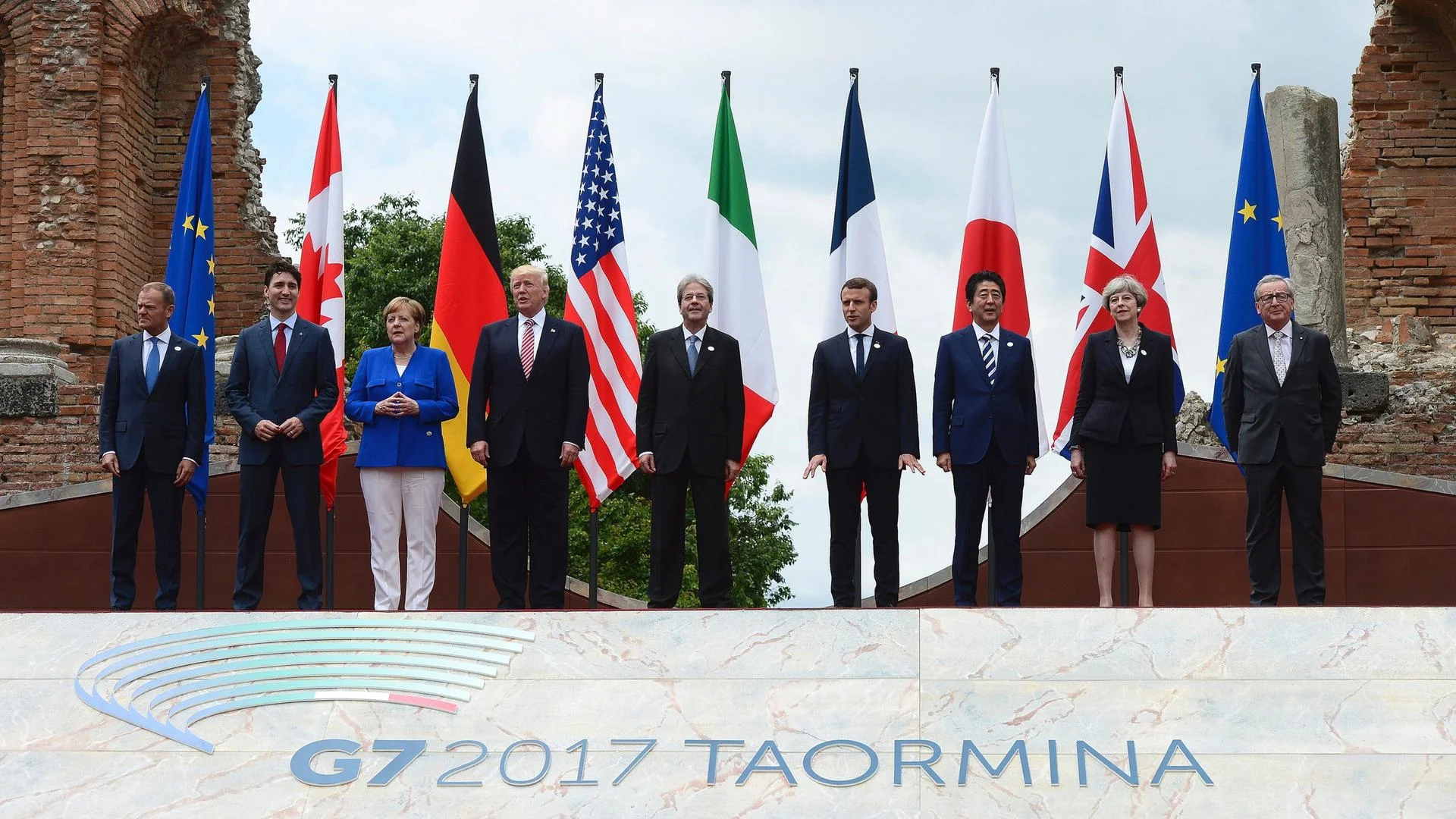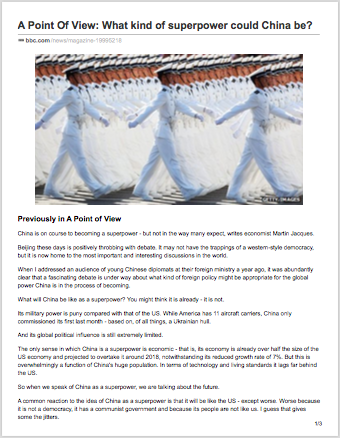



Measuring Globalisation
Define globalisation and explain the KOF and AT Kearney indices
Measuring Globalisation
Define globalisation and explain the KOF and AT Kearney indices
GUIDING QUESTION: How does global power and influence vary spatially?
““Globalisation is the growing interdependence of countries worldwide through the increasing volume and variety of cross-border transactions in goods and services and of international capital flows, and through the more rapid and widespread diffusion of technology.””
TASK 1
Write the definition in the middle of an A3 paper.
Highlight parts and draw pictures around the text to illustrate each of the points.
Watch the video below and conduct internet research into the concept of globalisation.
Add information, statistics, examples etc to your mind map.
How could you categorise the information on your mind map? Which categories would you use?
TASK 2 - Watch the video and add the benefits and costs of globalisation to your paper.
MEASURING GLOBALIsATION
flows of people
flows of information
flows of ideas
flows of capital
flows of goods
How could you measure and provide data for the following aspects of globalisation?
If you had to give a higher weighting to these figures, which would you say are more important as measurements of globalisation?
TASK 3: In groups, brainstorm ways that the above flows could be measured. Write in your notes and share with the class.
KOF INDEX OF GLOBALIsATION
TASK 4: Make detailed notes on the presentation above.
Weighting of the KOF index
KOF Rankings 2017
TASK 5: CALCULATING THE KOF INDEX
Download and read the document
Highlight information relating to how the KOF index is calculated
In three groups, make a mind map explaining how the KOF index measures globalisation
TASK 6: SPATIAL AND TEMPORAL DIFFERENCES IN GLOBALISATION
Explore the KOF page below and use the graph function to compare two countries of your choice
Describe how the level of globalisation changed over time (refer to data and statistics in your answer)
Suggest reasons for the changes you observe, based on what you know about the countries
SPATIAL PATTERNS
TASK 7: Draw a simple map to show the spatial distribution of globalised countries. Describe the distribution you observe in a short paragraph.
AT KEARNEY INDEX
A composite index (using a mix of variables) created by A.T. Kearney Inc. and Foreign Policy Magazine, measuring the evolution of interconnectedness compared to the base year 1998. The A.T. Kearney Index ranked 72 countries in 2007, combining 12 indicators grouped into 4 categories:
Economic integration (e.g. foreign trade)
Personal contact (e.g. international phone calls)
Technological connectivity (e.g. internet users)
Political engagement (e.g. participation in international treaties)
TASK 8: Make notes on the AT Kearney index and describe how it is different from the KOF index
EXAM PRACTICE
Use the essay planner to write a plan for the following question. Include details, facts and examples:
Describe how one prominent index measures global interaction. (10 marks)

Global Superpowers
Describe the economic, geopolitical and cultural influence of global superpowers
Global Superpowers
Describe the economic, geopolitical and cultural influence of global superpowers
According to you, which are the top 5 most powerful countries in the world and why?
TASK ONE: DEFINITIONS
A superpower is a state with a dominant position characterised by its extensive ability to exert influence or project power on a global scale. This is done through the combined means of economic, military, technological, political and cultural strength as well as diplomatic and soft power influence. (Source)
Hegemony, the dominance of one group over another, often supported by legitimating norms and ideas. The term hegemony is today often used as shorthand to describe the relatively dominant position of a particular set of ideas and their associated tendency to become commonsensical and intuitive, thereby inhibiting the dissemination or even the articulation of alternative ideas.
Define superpower and hegemony
Read this article and add some background information to help contextualise the definition of a superpower.
TASK TWO: HOW IS A NATION’S POWER MEASURED?
Explore the web page above
Define how power is measured
List the most powerful countries and briefly comment on the reasons for this
TASK THREE: UNITED STATES VS CHINA AS TWO SUPERPOWERS
Watch the two videos and read the two articles.
Make notes on the different aspects of global power for each country (economic, military and cultural)
The United States
The United States is considered by some as the world’s only superpower. However, this position is increasingly under question.
China
China’s rapid economic growth and the strengthening of military and growing cultural influence have led to many proposing that China is the world’s next superpower.
TASK FOUR: MULTIPLE GLOBAL SUPERPOWERS
An alternative hypothesis is that globalisation has led to multiple powerful nations, and that the idea of a single “superpower” is not appropriate to the modern era. If we accept this hypothesis, multilateralism (cooperation between nations) is an increasingly important feature of international relations.
Read and summarise the main arguments made in this article.
In what ways is multilateralism important in a globalised world of superpowers?
PLENARY
To what extent are the USA and China two world superpowers? Add your ideas on a post-it note, USA on the left, China on the right, points applying to both in the middle.

Powerful Organisations
Powerful organisations and global groups
Powerful Organisations
Powerful organisations and global groups
G7/8, G20 & OECD
The G7/8, G20, and the Organization for Economic Cooperation and Development (OECD) are all international organisations that bring together governments, scholars, and other experts to discuss and coordinate policy on a range of issues including economics, security, and the environment.
The G7/8 is a forum for the governments of the seven largest advanced economies in the world, including Canada, France, Germany, Italy, Japan, the United Kingdom, and the United States. The G20 is a larger group that includes the G7 countries as well as developing and emerging economies, such as China, India, Brazil, and Russia.
The Organization for Economic Cooperation and Development (OECD) is an intergovernmental economic organisation that works to promote policies that will improve the economic and social well-being of people around the world. It is made up of 37 member countries, most of which are high-income countries in Europe, North America, and Asia-Pacific.
Organization of the Petroleum Exporting Countries’ (OPEC) influence over energy policies
The Organization of the Petroleum Exporting Countries (OPEC) is a group of oil-producing countries that aims to coordinate and unify the petroleum policies of its member countries. It was founded in 1960 and currently has 15 member countries, including Algeria, Angola, Ecuador, Iraq, Kuwait, Libya, Nigeria, Qatar, Saudi Arabia, and the United Arab Emirates. OPEC plays a significant role in the global oil market and has the ability to influence energy policies around the world.
global lending institutions - International Monetary Fund (IMF) and New Development Bank (NDB)
There are also several global lending institutions that play important roles in the global economy. The International Monetary Fund (IMF) is an organization that works to promote global monetary cooperation, exchange stability, and economic growth. It provides financial assistance to member countries facing economic crises or in need of financial assistance to promote growth. The New Development Bank (NDB), also known as the BRICS Development Bank, is a multilateral development bank established by the BRICS countries (Brazil, Russia, India, China, and South Africa) to finance infrastructure and sustainable development projects in member countries.
POWERFUL ORGANISATIONS PRESENTATIONS
Create a 5 minute presentation on one of the powerful organisations/groups
G7/G8
G20
OECD
OPEC
World Bank
International Monetary Fund (IMF)
BRICS
New Development Bank
UN
WTO
Include:
A short description/history of organisation
Its mission/aims/goals and how these influence the world
The strengths and successes of the organisation
The weaknesses and criticisms of the organisation
Quality images to support your text
Bibliography















